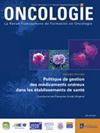基于网络药理学和分子对接探讨灵芝抗肺癌机制及其与免疫细胞浸润水平的关系
IF 1.4
4区 医学
Q4 ONCOLOGY
引用次数: 0
摘要
灵芝具有抗肿瘤作用,但其对肺癌的作用机制尚不清楚。本研究旨在利用分子对接和网络药理学研究灵芝如何抑制肺癌肿瘤的生长,以及这种关系与免疫细胞浸润程度的关系。 通过利用 TCMSP 数据库,发现了鹿角胶的治疗靶点和活性成分。根据随后几轮筛选中发现的靶点,构建了蛋白质相互作用(PPI)网络。此外,还利用 GO 和 KEGG 进行了富集分析。在 AutoDock Tools 和 PyMOL 的帮助下进行了分子对接。最后,我们研究了免疫细胞与肺癌之间的关系以及肺癌与免疫细胞之间的共性。 根据网络药理学研究,绿藻抗肺癌活性的主要靶点是ADRB2、OPRM1、SLC6A4和JUN。肺癌斗士麦角甾醇的主要成分是甘露醇 B、甘露酸 E 和 beta-谷甾醇。分子对接分析表明,β-谷甾醇与 JUN 的对接作用稳定性最高。免疫浸润分析表明,绿藻治疗肺癌的相关生物标志物与免疫浸润细胞之间存在潜在的相关性。 绿藻通过靶向多种成分和信号通路、促进癌细胞凋亡以及与免疫反应相互作用来抗击肺癌。这为今后研究绿巨人治疗肺癌的机制提供了潜在的途径。本文章由计算机程序翻译,如有差异,请以英文原文为准。
Exploring the anti-lung cancer mechanism of Ganoderma lucidum and its relationship with the level of immune cell infiltration based on network pharmacology and molecular docking
Ganoderma lucidum has anti-tumor effects, but its mechanism of action against lung cancer is not clear. This study aims to use molecular docking and network pharmacology to investigate how G. lucidum inhibits tumor growth in lung cancer and how this relationship relates to the degree of immune cell infiltration.
By utilizing the TCMSP database, the therapeutic targets and active ingredients of G. lucidum were discovered. Based on the targets found in subsequent rounds of screening, a protein interaction (PPI) network was constructed. Additionally, enrichment analysis was conducted using GO and the KEGG. The molecular docking was conducted with the help of AutoDock Tools and PyMOL. Finally, we investigated the relationships between immune cells and the commonalities between lung cancer and.
The primary targets of G. lucidum’s anti-lung cancer activities, according to network pharmacology studies, are ADRB2, OPRM1, SLC6A4, and JUN. The primary components of the lung cancer fighter Ergosterol are ganoderal B, ganolucidic acid E, and beta-sitosterol. The molecular docking analysis revealed that beta-sitosterol had the highest degree of stability in its docking interaction with JUN. The immune infiltration analysis indicated a potential correlation between the biomarkers associated with G. lucidum treatment for lung cancer and the immune infiltrating cells.
G. lucidum combats lung cancer by targeting multiple components and signaling pathways, facilitating cancer cell apoptosis and interacting with immune responses. This elucidates potential avenues for future research into G. lucidum’s mechanisms in lung cancer therapy.
求助全文
通过发布文献求助,成功后即可免费获取论文全文。
去求助
来源期刊

Oncologie
医学-肿瘤学
CiteScore
1.30
自引率
11.10%
发文量
32
审稿时长
6-12 weeks
期刊介绍:
Oncologie is aimed to the publication of high quality original research articles, review papers, case report, etc. with an active interest in vivo or vitro study of cancer biology. Study relating to the pathology, diagnosis, and advanced treatment of all types of cancers, as well as research from any of the disciplines related to this field of interest. The journal has English and French bilingual publication.
 求助内容:
求助内容: 应助结果提醒方式:
应助结果提醒方式:


